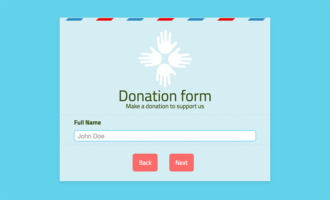You don’t have to craft a mission statement to be successful as a nonprofit. Many organizations get by without one, but if you make that choice, you’re setting yourself up for some potential problems down the line.
A mission statement can serve as a barometer for your business. As you make difficult decisions, interact with the community, offer different services, and promote your brand, your mission statement gives you a center to work from. As such, it’s a vital tool in keeping you focused on your primary goals and identity at any given time.
It can be tempting to solidify that identity in your own head when starting your nonprofit and leave it at that. But if you do, you risk letting your goals and points of emphasis slip as you add members to your team or get caught up dealing with urgent challenges.
You need a solid backbone to keep your nonprofit focused. What’s more, the mission statement isn’t just informative for you; it’s also beneficial for volunteers, staff, and community members as it helps them understand what you really stand for and are trying to achieve.
There are plenty of reasons to create a mission statement, but establishing a good framework begins with understanding precisely what a mission statement is meant to accomplish.
What is a mission statement?
Writing a mission statement isn’t terribly difficult. However, there’s one major challenge: understanding exactly what a mission statement is and what it should achieve. It’s easy to inadvertently stumble into creating values, purpose, or vision statements when thinking about your mission.
In short, your mission statement is a concise explanation of what your nonprofit does and how it wants to do it. For example, NASA is famous for having a great mission statement that describes what it does:
“Drive advances in science, technology, aeronautics, and space exploration to enhance knowledge, education, innovation, economic vitality and stewardship of Earth.”
It’s important to focus on the primary goal of your organization as you develop your mission statement. For example, if you run a scholarship fund designed to provide access to science, technology, engineering, and mathematics (STEM) education opportunities for young women, a mission statement might be something like the following:
“We maintain funds to provide young women with access to scholarships as they pursue undergraduate education in STEM disciplines.”
Conversely, you’d want to avoid an overly detailed, nuanced mission statement like “We believe that people of all genders should have equal access to education and will work to manage a trust fund devoted to giving young women access to capital that will empower them to pursue STEM educational opportunities.”
Not only is this mission statement unnecessarily wordy, but it also includes a values statement — “We believe that people of all genders should have equal access to education” — that can distract from your core goal.
If you believe that individuals of all genders should have equal access to education, then why is the scholarship only for young women? That’s a question you can probably answer, but by incorporating the values statement into your mission, you create potential confusion among team and community members.
Focus on what you do in your mission statement. In many cases, it’s easiest to create a mission statement if you also create vision and purpose statements. These work together as follows:
- A purpose statement explains why your nonprofit exists/what it is trying to achieve.
- A vision statement defines what you want the communities you serve to look like as a result of your work.
- A mission statement clarifies the actual work that you’ll do in a concise way.
Tips for crafting a powerful mission statement for nonprofits
Once you have a clear understanding of what a mission statement is, you’re in a good place to craft your own. But there are some issues to consider to position yourself for success. Here are some quick tips to help you get going:
- Be concise. You want the mission statement to be memorable and easy to keep in mind as you make operational decisions.
- Reinforce your ideas. Many mission statements are painstakingly crafted, only to be ignored once they’re in place. Keep reinforcing your mission to make the statement valuable.
- Focus on why you started the nonprofit in the first place. Show how that purpose translates into the tangible operations that make up your mission.
- Don’t get too hung up on details. Your mission statement is a guide, not a prescription.
- Get feedback. You want your mission to be easily understood by volunteers, prospective staff, clients, and potential partners. Ask friends or family to read what you craft and tell you what they think so you can get some outside perspective on how you’re communicating your mission.
- Allow it to change. Missions change and shift over time. If you try to create a mission statement that’s permanent, you can end up with an overly broad, far-reaching mission that doesn’t adequately describe your current situation. Be specific, and that means applying your current context to your mission and revisiting the statement every couple of years.
A good mission statement is a simple thing, but it can be invaluable in guiding your business and keeping you focused on your primary objectives.
What is the purpose of a nonprofit mission statement?
Nonprofit mission statements help convey what your nonprofit is all about. They are used to show what’s unique about your organization and how your work benefits your specific audience.
What are the key components of a good mission statement?
When writing a compelling mission statement, be sure to include
- A unique perspective. What is your organization doing that no one else is? How are you using your tools and resources to better serve your intended audience?
- Only the essentials. While you may have a lot to say to your audience about your organization, your mission statement should only include the essence of your work. You can elaborate on other parts of your nonprofit in other content.
- Your core values. Your mission statement should weave in nicely with your organization’s core values. Try to reflect your nonprofit’s core principles in your mission statement so that they work hand in hand.
5 great mission statement examples for nonprofits
Many nonprofits have great mission statements — both long and short — that accurately reflect their mission. Consider some of these examples when writing your own.
1. Feeding America
“Our mission is to advance change in America by ensuring equitable access to nutritious food for all in partnership with food banks, policymakers, supporters, and the communities we serve.”
2. St. Jude Children’s Research Hospital
“The mission of St. Jude Children’s Research Hospital is to advance cures, and means of prevention, for pediatric catastrophic disease through research and treatment. Consistent with the vision of our founder Danny Thomas, no child is denied treatment based on race, religion or a family’s ability to pay.”
3. Human Rights Campaign
“The Human Right Campaign and the Human Rights Campaign Foundation together serve as America’s largest civil rights organization working to achieve LGBTQ+ equality.”
4. Ronald McDonald House Charities
“The mission of RMHC is to create, find, and support programs that directly improve the health and well-being of children and their families.”
5. Doctors Without Borders
“Doctors Without Borders/Médecins San Frontières (MSF) cares for people affected by conflict, disease outbreaks, natural and human-made disasters, and exclusion from health care in more than 70 countries.”
What are the misbeliefs about mission statements?
Some may see mission statements as merely an extension of a nonprofit’s or company’s marketing strategy — another way to make themselves look good for their audience by paying lip service to a cause. While a mission statement is part of your organization’s overall marketing efforts, an honest, powerful mission statement can guide your work and help you find like-minded partners.
Great mission statements help introduce your organization to potential partners by giving them an overview of your work — effectively letting them see if they’d like to associate themselves with what the organization stands for. Mission statements allow nonprofits to communicate to their audiences why they exist, and what their beliefs and goals are, in a few sentences or less.
Another common misbelief that people have about mission statements is that they cannot be edited or changed once they are created. Nonprofit organizations and businesses change over time, and their mission statements can and should change with them. Keeping your mission statement the same when it doesn’t align with your organization anymore can make it misleading to your audience and ineffective in guiding your decision-making.






































































Send Comment: